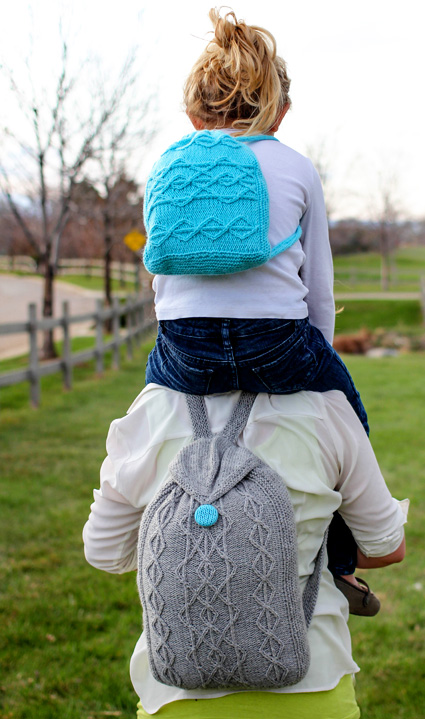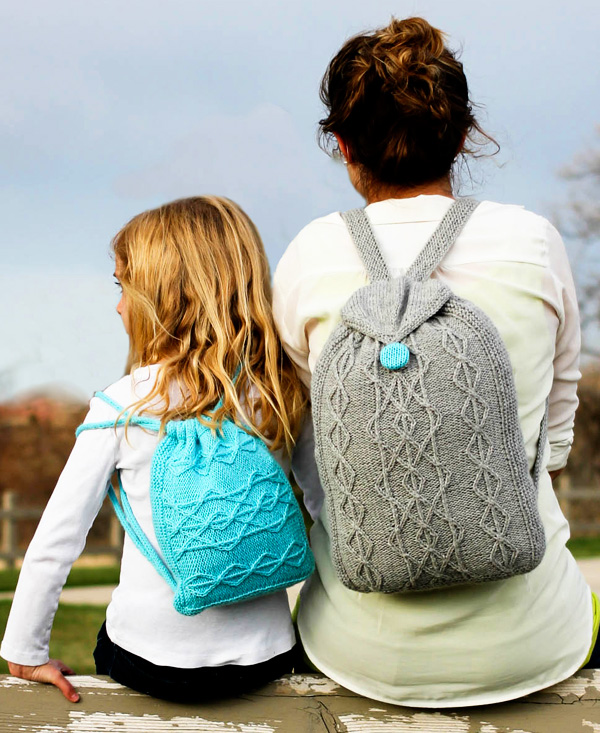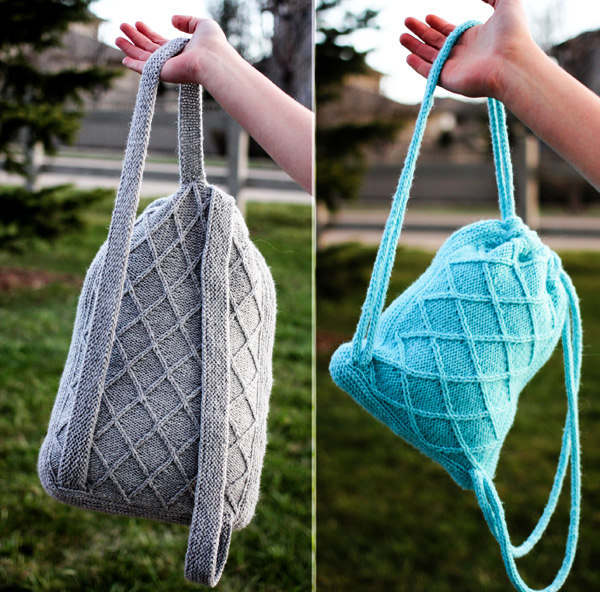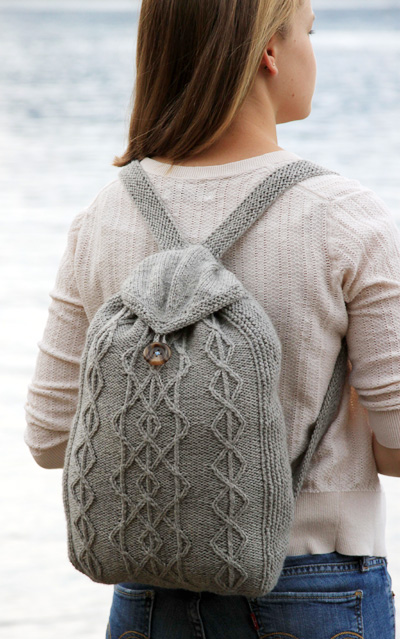

|
|
|

As a youngster, I simply loved de-organizing things. I would wander about the house, collecting random, unrelated objects, and stuffing them into different bags to prepare for 'adventures'. Toys, food products, mismatched socks, wallets, and my sister's possessions are some of the things you could find in my adventure bags. This led to the formation of one of my childhood nicknames: "Bag Lady". Although I no longer enjoy disorganizing things, (not to the same extent, anyways) my bag stash has continued to grow. So, to simplify things, I wanted to create a backpack that I could reach for every time I left the house. The Adventure Rucksacks, these cabled backpacks, were the result. The roomy pockets, both cinched by drawstrings, allow for the placement of an imaginative range of items: toys, food products, mismatched socks, wallets, and your sister's possessions, etc... Now I use them for my every expedition. Enjoy! Hint: The larger size works great as a school backpack. The smaller size, if not used as a backpack, could also make a great lunchbag. |
||
 |
Tweet
 |
|
|
SIZE |
|
|
FINISHED MEASUREMENTS Small bag: |
|
MATERIALS Notions |
|
GAUGE |
21 sts/34 rows = 4" in stockinette stitch Note: While correct gauge is not crucial for the success of this project, any variation may affect the finished size and total yardage required. |
|
PATTERN NOTES |
|
Construction: This rucksack is knitted by first making the front cable panel. Then, stitches are picked up for the gusset on three of the four sides to give depth to the bag. After creating the back panel, the back panel is sewn to the gusset. The drawstring, flap, and straps are added last. Note that the odd rows of the charts are WS rows and the even rows are RS rows. C2F: Slip 1 st to cable needle and hold in front, k1; k1 from cable needle Chart 1 (Worked over 15 sts) Chart 2 (Worked over 22 sts) Chart 3 (Worked over a multiple of 10 sts + 12) I-cord: |
The charts for this pattern are very large and fit on a letter-sized page. Click here and print the resulting page. |

|
|
DIRECTIONS 
With MC and circular needle, CO 55 sts. Do not join. Row 1 [WS]: P2, work Row 1 of Chart 1, work Row 1 of Chart 2, work Row 1 of Chart 1, p2. Row 2 [RS]: K2, work Row 2 of Chart 1, work Row 2 of Chart 2, work Row 2 of Chart 1, k2. Cont in patt as set, working chart repeats as designated and 2 sts on either side of charts in st st, until Rows 1-14 of Chart 1 have been completed a total of 4[8] times, ending on Row 14 of Chart 1 and Row 12[2] of Chart 2. Work 2 rows more in patt, ending on Row 2 of Chart 1. BO all sts purl-wise and block FRONT PANEL before continuing. GUSSET Size Large Only: All Sizes: 
With MC and circular needle, CO 56 sts. Do not join. Row 1 [WS]: P2, work Row 1 of Chart 3, working pattern repeat four times total, p2. Row 2 [RS]: K2, work Row 2 of Chart 3, working pattern repeat four times total, k2. Continue to work Chart 3 with St st borders, repeating Rows 1-20, until a total of 2[6] repeats (40[120] rows) of Chart 3 have been worked. Rep Rows 1-10[2] once more. BO all sts purl-wise. Block BACK PANEL to same dimensions as FRONT PANEL. Seaming Weave in all ends into the stockinette edging on either side of PANELS unless lining the bag is desired. If lining the bag, secure ends to prevent them from coming undone. TOP EDGING Starting with a WS row, work in st st for 11 rows. BO knit-wise on foll row. Repeat for other side of bag. Size Large Only: Rounds 1-2: (K2tbl, p2) to end of round. BO all sts in (k2tbl, p2) pattern. Weave in ends. CO 3 sts and make i-cord 28 inches long. Starting at the center of the FRONT PANEL, weave string through holes created by yarnovers in TOP EDGING, making sure both ends come out of holes toward the front on either side of center. Knot both ends of i-cord. STRAPS (Make 2) Attach one end of one strap to a safety pin (this makes it easier to bring through the TOP EDGING) and take through one "tube" created by the TOP EDGING, then back through the other, so both ends of the strap sit opposite each other at center of same gusset. Sew the ends of the I-cord straps together and sew them to their respective bottom corner. Repeat with other strap on opposite side of bag. Size Small Only: Continue to FINISHING section below. Size Large Only continues here: With the BACK PANEL facing, pin straps to bag, sewing each strap to either side of center of BACK PANEL (below TOP EDGING) using mattress stitch. Sew bottom of straps to cast on edge at either end of BACK PANEL.  With MC and circular needle, CO 45 sts. Do not join. Beg with a purl (WS) row, work 13 rows in St st. Row 14 [RS]: K1, ssk, knit to last 3 sts, k2tog, k1. 2 sts dec'd. Row 24: K1, (ssk, k3) three times, sk2p, (k3, k2tog) three times, k1. 27 sts. Flap Edging Knit 3 rows, then BO knit-wise. Using mattress stitch, seam CO edge of flap to the edge of the BACK PANEL just above straps. It is helpful to use locking stitch markers to designate placement. Weave in ends. Button Loop |
|
FINISHING For Size Small, get the straps wet and stretch them a bit. Let them dry by placing something relatively heavy, like a book, inside and hanging the bag on a doorknob or drawer-pull. This will help the straps relax. For Size Large, surreptitiously remove a button from a relative's cardigan (1.25-inch to 1.5-inch diameter) and sew to front panel in desired placement (make sure the flap closes when you put items in -- don't sew the button too far down). For a more durable bag, line the inside and straps with fabric. |
| ABOUT THE DESIGNER |
|
|
|
Pattern & images © 2013 Cassidy Clark. Contact Cassidy |